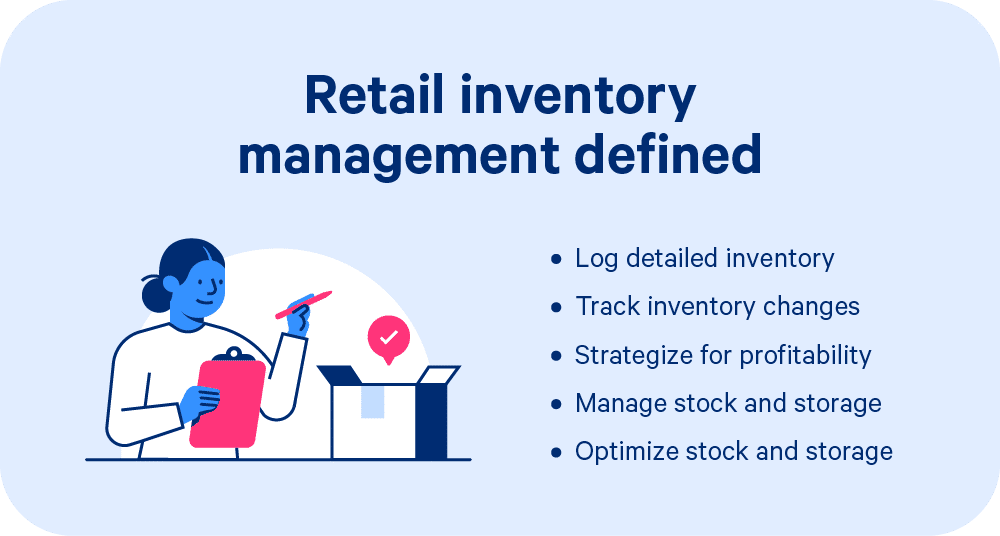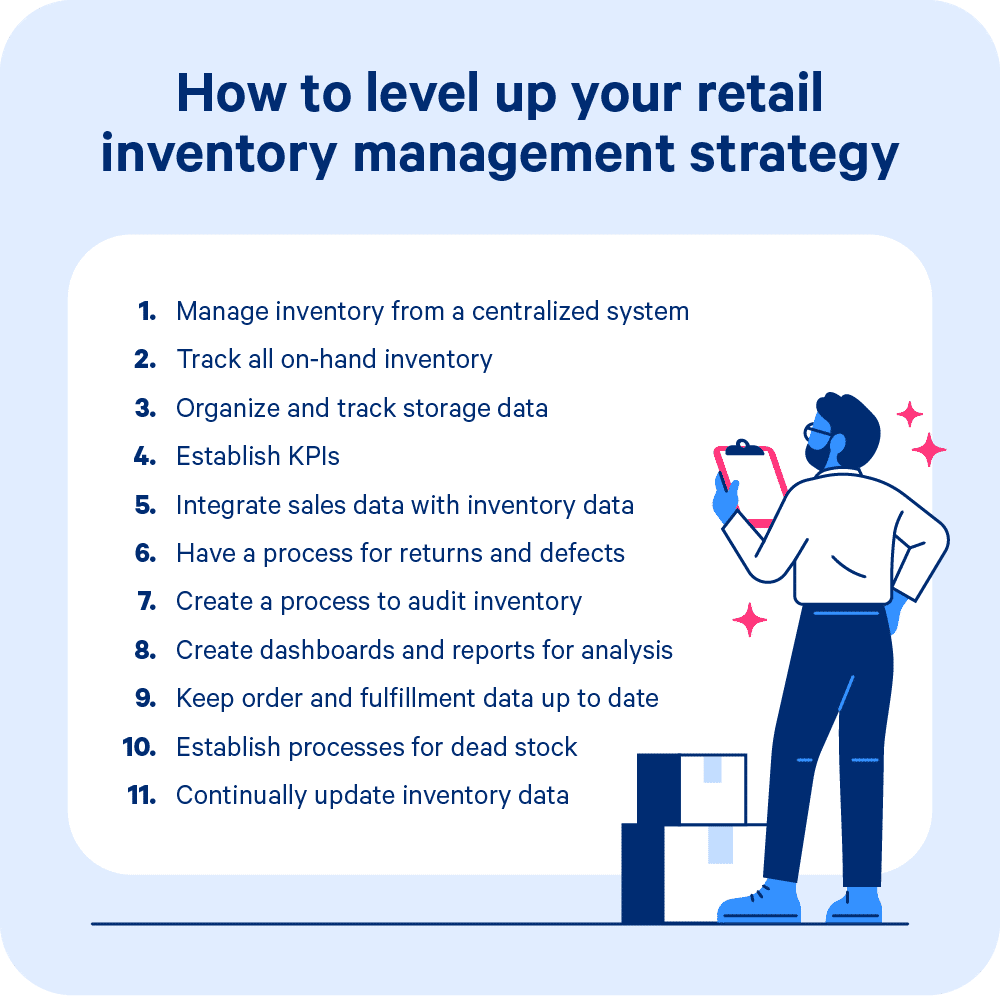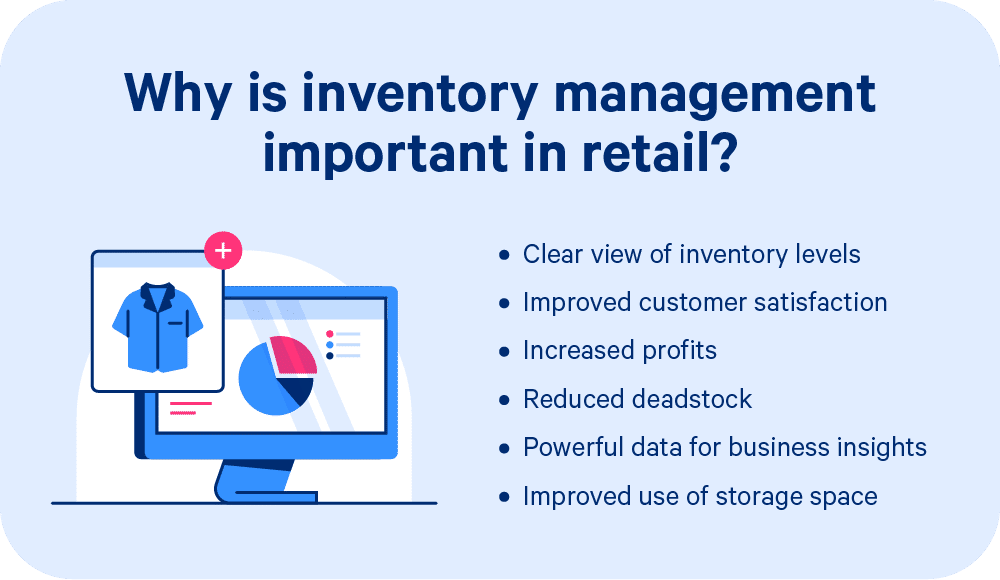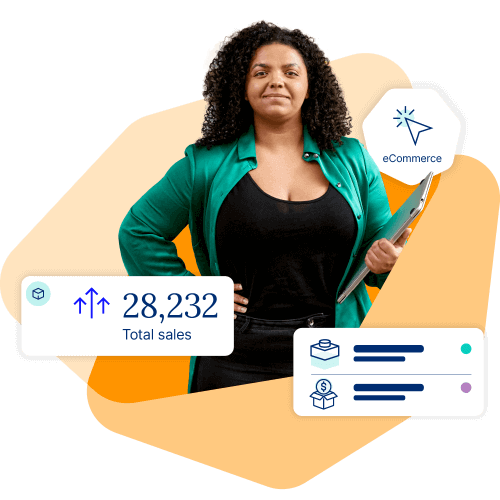

Every retailer wishes they could see into the future. Imagine knowing exactly how many items to carry to meet customer demand. Unfortunately, this is impossible without a magic crystal ball. The good news is that every retailer shares the same concern. The answer to this problem is retail inventory management. This is different from inventory management, which covers the entire supply chain.
The retail inventory management process has two main concerns: Retailers need enough stock to meet demand, and they must manage the stock efficiently. Basically, you don’t want too much or too little inventory. Depending on the size of the retail business, there can be multiple retail and warehouse locations to consider.
No matter what you sell, retail inventory management is the key to profitability and customer satisfaction. Research shows that sales can grow by an average of 6% when companies correct their retail inventory errors. The same study revealed that 60% of inventory records are inaccurate. Businesses can make improvements by following best practices, so let’s explore the best practices for retail inventory management.

Retail inventory management refers to the systems and processes used by retailers to ensure stock levels meet customer demand without wasting storage space. The goal is to have just enough inventory to satisfy customers while optimizing storage and ordering for profitability. Many businesses use inventory management software to stay efficient and competitive.
Retail management is more than just inventory management but inventory plays a huge role for obvious reasons. Businesses can’t survive without the inventory available for customers to buy. Modern businesses can manage inventory for multiple locations, including online stores, and proper retail inventory management is key to customer satisfaction.
Retail inventory accounts for more than the finished goods a business sells, it also includes items for on-site repair and maintenance services. Knowing what types of inventory you have is an important part of the management process.
There are many types of retail inventory, such as:
Many retailers can have in-house manufacturing, especially small businesses. Woodworkers, jewelers, and microbreweries often have multiple types of in-store retail inventory.
For example, a craft beer company can store raw materials (hops and barley), work in progress (fermenting beer), finished goods (bottled products), packing materials (bottles, cans, boxes), and more. The Winery use inventory management to leverage retail data and streamline operations.
The complexity of retail inventory management increases with scale. Establishing best practices early will set you up for success, whether your business is big or small. Consider how each best practice below can apply to your organization.
Evaluate your retail inventory management system at a macro level before diving into specific issues. A total system audit can provide up-to-date information on your inventory, vendors, and more. You can use this data to update your current retail inventory management system or populate a new system.
A thorough system evaluation can highlight the strengths and weaknesses of your current retail inventory management processes. It’s helpful to know where you struggle the most so you can choose the best system for your needs. For example, a business struggling to meet seasonal demand might want a platform with advanced reporting analytics.
Establishing KPIs is important for tracking performance, monitoring issues, and meeting important business goals. KPIs help businesses communicate with stakeholders, set quarterly goals, and keep themselves accountable. KPIs should be S.M.A.R.T., which means they represent business goals that are specific, measurable, attainable, relevant, and timely.
Establish S.M.A.R.T. retail inventory management KPIs, like:
Hindsight is 20/20. This is especially true for retail inventory management, but only if you keep accurate data. You can learn a lot by analyzing past sales and spotting trends, and demand forecasting will help your business make informed inventory management decisions.
Look for trends in:
Sales data can be useful for strategic planning and pricing. For example, strategically timed in-store offers can help clear out valuable storage space when demand dwindles for seasonal items. With sales analysis, you can pinpoint the most optimal time to do this.
You wouldn’t plan a picnic without checking the weather. And you shouldn’t order inventory without forecasting demand. Proactive forecasting is about looking ahead so you can make smart inventory decisions. This way, you can order the ideal inventory to keep customers happy while maximizing storage space.
Just like forecasting the weather, you want reliable data. Spreadsheets and file folders aren’t enough to stay competitive in the modern business landscape. Choose a platform with advanced reporting capabilities to put your data to work and make better decisions.
The customer is always right. By keeping your customers top of mind, you can feel confident that you are making the right business decisions. Maximizing profits is important but should never detract from the customer experience. Customers are delighted when they can buy what they want but will never be impressed by your optimal storage space.
Retail inventory management can ensure customers always get what they want, even if you don’t have it in store. Outlets with multiple locations can pull available stock from other stores. Dropshippers can use vendor information stored within their inventory management system to ship items directly to customers.

Thoroughly documenting your inventory and vendor details is the first step in retail inventory management. But don’t set it, and forget it. Up-to-date documentation is a key part of accurate forecasting.
Your retail inventory documentation should include details such as:
Log your products with as much detail as possible. Even photos can help sales staff impress customers and move inventory. Consider every department’s needs and create processes for updating inventory details. You can share this up-to-date information across systems for order fulfillment, point of sale, and more.
No system is perfect, and errors happen. Strong supplier relationships make addressing things like delayed orders, missing or damaged items, stock outages, or missing payments easy.
Communication is key to a solid relationship. Suppliers appreciate when you update them, and a positive relationship can improve communication and create trust. A relationship built on trust will help you negotiate prices with suppliers. Retailers need suppliers, so consider these relationships as part of your retail inventory management process.
Choose the inventory technique that best suits your business. It’s important to consider things like the stability of your cash flow, cost fluctuations, and your business’s location.
Examples of popular inventory management techniques include:
Functional warehouse layouts allow clear visibility, smooth transfer of goods, and easy access to inventory and equipment. This helps make order fulfillment fast and easy.
Some examples of warehouse layout designs include:
Read up on warehouse layout best practices to make the most of your space. A well-organized warehouse helps improve retail inventory management. Functional warehouses let employees focus on important things like receiving inventory and updating tracking information.
Warehouses can improve functionality when you store goods logically based on their type or category. Clear categorization can help you store important goods for easy picking, while you may store less important goods in harder-to-reach areas.
Best practices for storing inventory:
Storing inventory with no strategy can chew up profits because it slows down everything. Items become hard to retrieve or, even worse, impossible to find without a thorough audit. You want a system that ensures all products are retrievable and in good condition.
Deadstock should be eliminated immediately. Holding inventory costs (also known as inventory carrying costs) typically equal 15%–30% of the inventory’s total value. It can feel like a loss to sell deadstock at a low price, but there is little benefit to inventory that takes up valuable storage space.
You can get rid of deadstock in a few ways:

Surplus stock is a necessary part of giving customers a great experience. Better to have too much stock than too little. And to avoid deadstock, planning for surplus stock is important.
Seasonal forecasting can give you a clear picture of demand, including when it begins to slow down. Account for these times and get creative about moving your surplus stock.
Think of strategic ways to move stock and keep customers excited:
Tracking in-transit inventory supports accurate forecasting and budgeting. Understanding the length of time between ordering and receiving inventory is important. The more data you have, the better your ability to plan.
Tracking moving inventory is also important for relationship management. Suppliers and retailers both share concerns over inventory transportation. Customers will also appreciate knowing where an item is and when to expect it. Inventory tracking this way can put customers at ease and stop them from going to another retailer.
For best results, you should audit inventory once every quarter. This need can vary depending on your industry and how fast stock moves. Every business should perform a thorough inventory audit at least once a year for accurate data as part of their retail management process.
When you properly account for inventory, you can optimize storage and increase profit opportunities. Inventory audits also reveal damaged, out of date, and recalled goods. Remove these items because you can’t sell them. You can account for deadstock and subsequently put it on sale to create more storage space for on-demand items.
Automation can improve accuracy, streamline processes, and provide actionable data for your business. Automated retail inventory management software can help you handle production and management with automated dashboards, reports, and reminders. Integration abilities can even sync inventory data across all your stores and devices.
Almost 46% of small and medium-sized businesses track their inventory manually or don’t track it at all. Retail inventory management software can save you lots of time but also help you make smart, data-driven business decisions.
Retailers, wholesalers, and online sellers use products like Cin7 Core for:
Alongside best practices, we want to answer some frequently asked questions about retail inventory management.
You can monitor inventory levels in retail stores with a system called retail inventory management. Inventory gets counted when it arrives at the store and when customers buy it.
Businesses also need to perform inventory audits regularly to ensure their counts are accurate. Audits will account for inventory that is missing, damaged, or recalled.
Accountants use the retail inventory method to estimate the value of a business’s current inventory over a specific period. The process is simple, but the results are only an estimate. Businesses use this method to avoid a costly manual process.
The main benefits of retail inventory management are:
Retail inventory management software provides tools for:
The best retail inventory management software can scale alongside your business as it grows. Switching platforms can be time-consuming and create room for error, so you’ll want to consider where your business will be in the future.
Your software should also provide features that help your business grow. Choose a solution that supports your ability to streamline operations, increase sales, lower operating costs, and improve customer satisfaction.
If you are a small or medium-sized business that wants to increase sales and be more efficient, book a demo of Cin7 today. Let us help you reach your business goals quicker and easier.


Product companies have to innovate quickly in the coronavirus era. With increases in online shopping and demand for click-and-collect, retailers and wholesalers are doing everything from shifting their sales-channel focus to fundamentally changing how they do business.

Lost, obsolete or overstocked inventory drives up costs and destroys margins. Without inventory visibility, you won’t know your business is suffering until it’s too late.